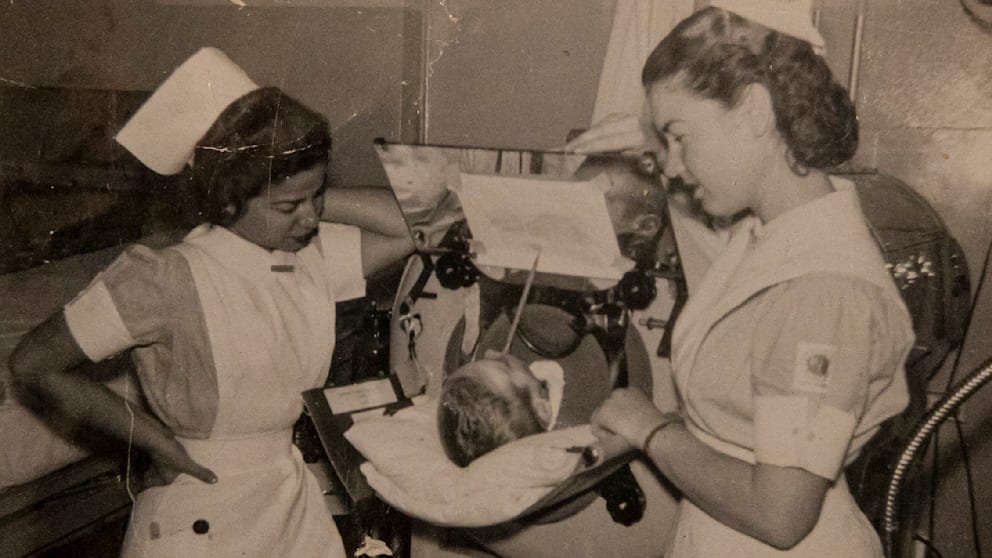Mucus fills the lungs and breathing becomes more difficult. A panicked feeling of slowly suffocating. A plea echoes in six-year-old Paul Alexander’s head: “Please! Help me breathe!” But he can’t speak and makes desperate noises. The nurses still ignore him. Another night full of fear of death.
It’s 1952. Paul Alexander is in Parkland Hospital Dallas (Texas) in an “iron lung,” a steel tube that allows breathing through negative pressure.
There are dozens of these 300 kilogram monsters throughout the hall. Children’s heads stick out.
Children in iron lungs in a US hospital in the 1950s. Paul was one of the children
This is raging in the USA Poliovirus. Of the 58,000 cases that year, around 3,100 victims died and suffocated in agony. Or remain paralyzed. Like little Paul.
When Paul came home from playing months before, his mother knew straight away: Them dreaded illnesst has caught up with the family!
In the hospital the child was saved by a tracheostomy. 18 months of hellish torment follow: In the polio ward, in addition to his own torment, he experiences the horror of crying and dying children.

Paul Alexander lives in this home in Dallas, Texas
71 years later: a simple apartment in Dallas. Paul Alexander is 77 today. Paralyzed from the neck down, he is still stuck in the massive lung machine.
“Polio Paul,” as the record patient is called, told BILD during his visit that he preferred this “old, actually ingenious breathing machine” instead of modern technology. He calls her “my old steam locomotive” almost affectionately.
His life – so brutally thrown off track by the devil Infectious disease – Paul Alexander brought an entry into the Guinness Book of Records: At more than 70 years old, no person has survived that long with an “iron lung”.
His irrepressible will to live despite the most severe disabilities became an inspiration for millions.
The key to Paul Alexander’s career: After his time in the hospital, he learned to gasp with the help of a therapist.
This technique forces air into the lungs. This allowed the polio victim limited freedom – outside of the like a Mini submarine giant looking device.
He graduated from high school, studied, became Attorney. He received clients in a wheelchair and wearing a tailored suit.

Paul Alexander is sitting in a wheelchair in a three-piece suit as he completes his legal training. Gasping helped him survive during the day without the iron lung when he was younger
“It was just a great feeling to be able to help people,” he says. With his irrepressible will to live, he also made it onto airplanes. Or strip clubs. He saw the sea, gambled in the casino, and fell in love with a “wonderful fellow student” named Claire while studying.
Lying in the machine with a pen in his mouth, he initially painted paintings as a child. He recently used it to type his autobiography line by line.

Paul Alexander as a child in the machine. He painted with his mouth
With the title “Three Minutes for a Dog” he wanted to remember the bet he once made with his therapist: If he lasted three minutes without the ventilator machine, he would have one Got a dog as a gift. A year later he gave birth to the puppy “Ginger”.
It was the starting signal for a limited life outside the steel prison.
Today the tube has once again become his permanent home. Pensioner Paul Alexander allows himself to leave the labored breathing outside the colossus to the familiar machine.
How does he spend his days? His head lies on a cushion, his body is stuck in the tube. A beige plastic ruff slightly constricts the neck, acting as a seal for pressure equalization.

Paul needs help around the clock. There is a second iron lung in the room – for spare parts
There is a telephone next to it. He communicates digitally via Amazon’s virtual assistant “ Alexa.” He can use the pen to type on a keyboard. The computer screen is next to it. Above all, he likes “good food” (favorite: fried chicken) and interacting with friends.
With his current carer, Patricia Morton, he doesn’t have to be lonely. They get along great, a kiss on the mouth lightens up everyday life.
And also a few beers in the evening. There is another “iron lung” in the corner of the room. Mainly for spare parts, as production stopped in the sixties. A battery is available for short-term power outages and a generator outside for longer ones. Apart from the polio paralysis, he feels “strong”, even in excellent health, he laughs.
The irrepressible will to live can also be seen in his sparkling eyes.
“I thought I was dead”
When Alexander came to after the first emergency operation seven decades ago, he was stuck in the steel tube, unable to move or speak. “At first I thought I was dead,” he remembers, as if it were yesterday. He heard a nurse talking to a doctor. “He shouldn’t actually be alive anymore,” they said about him.
The polio victim today: “That made me so angry! And spurred me on to keep surviving!”
During the lonely year and a half in the clinic, he pondered what would become of his life. After his body was paralyzed, his indomitable spirit – and his brain – remained: “I knew I had to get a good education, and I wanted to inspire people!” That became his life motto.
Now – as a reward for his efforts – he is moved when he receives messages from all over the world. And he is proud when desperate people ask him for advice.
The strong faith of the man of Greek origin helped him in desperate moments, even if he often quarreled with God, as he says: “It hurts that so many children were taken from us by the epidemic!”
He himself judges that in the end it was he who defeated polio. He also has an explanation for this: his grandfather comes from that Greek Sparta, “and fighters traditionally come from there,” he laughs.
Only the development of vaccines in 1955 ended the terrible epidemic.
Polio Paul would also like to use his fate to warn today’s parents who do not have their children vaccinated: “Don’t gamble with the life of your offspring!”

